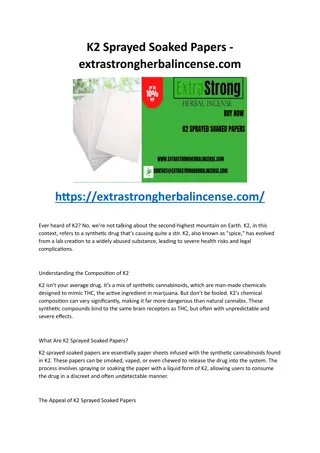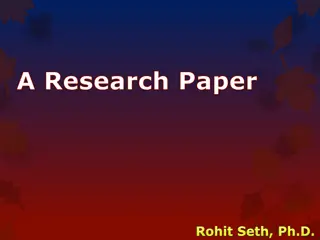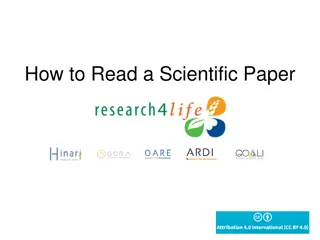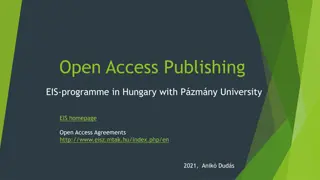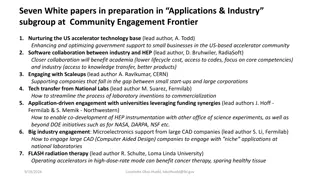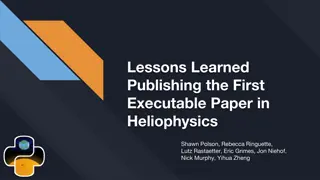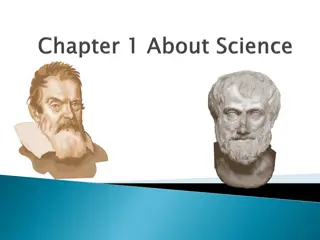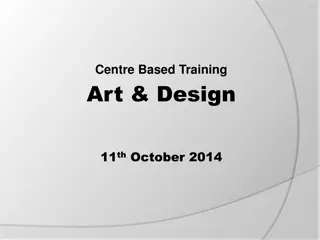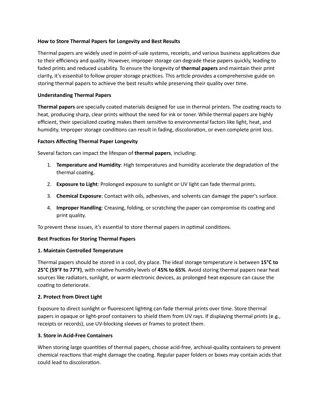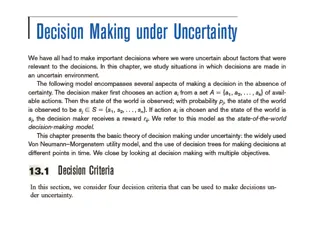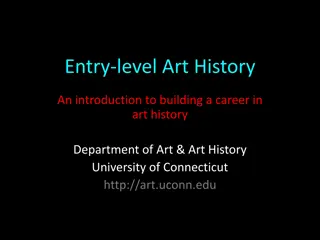Art of Publishing Scientific Papers
This presentation delves into the standard format of scientific articles, customizing content for journals, ethical considerations, and strategies for successful publishing. It emphasizes the importance of clear writing, proper research design, and technical accuracy to enhance the chances of publication in reputable journals.
Download Presentation

Please find below an Image/Link to download the presentation.
The content on the website is provided AS IS for your information and personal use only. It may not be sold, licensed, or shared on other websites without obtaining consent from the author.If you encounter any issues during the download, it is possible that the publisher has removed the file from their server.
You are allowed to download the files provided on this website for personal or commercial use, subject to the condition that they are used lawfully. All files are the property of their respective owners.
The content on the website is provided AS IS for your information and personal use only. It may not be sold, licensed, or shared on other websites without obtaining consent from the author.
E N D
Presentation Transcript
Scientific writing Or the art of publishing a scientific paper Habiba Djebbari, Guy Lacroix, Luca Tiberti 2017 PEP Annual Conference Sunday May 11 Nairobi - Kenya
Outline of the presentation Standard format of scientific articles Strategically targeting academic journals Customizing an article for specific journals External reviews and comments Ethics and legal aspects Plagiarism Replication Citation software Predatory journals PEP acknowledgments
Preliminary remarks 09:00-10:30 Joint CPP/CWEN Panel: Publishing in Economics / Table ronde AdP-RF : Publier en conomique Publish Organizers Winter, Jennifer (University of Calgary) Schirle, Tammy (Wilfrid Laurier University) Chair Winter, Jennifer (University of Calgary) Panelists Bombardini, Matilde (University of British Columbia) Hoynes, Hilary (University of California, Berkeley) Rivers, Nicholas (University of Ottawa) Lemieux, Thomas (University of British Columbia) Schirle, Tammy (Wilfrid Laurier University) Friday, June 2, 2017 Loc. T.B.A. Editor Canadian Journal of Economics Founding Editor, AEJ : Applied Economics Journal of Economics and Environmental Management Founding Editor, AEJ : Applied Economics Canadian Public Polic
In a nutshell Short Intro, Big picture The paper holds in the abstract Quality of writing is all (proof reader) Editor: Why should I publish this paper ? Too many reasons to reject a paper If editor not specialist, asks referee a one-liner: reject or carry on Google Scholar and REPEC: used to find referees Most papers are rejected for either of two reasons: Contribution too thin/ poor research design Poorly written Technical sophistication not a substitute for good research idea
Publishing in good journals Essential ingredient of good article: a good idea. To be published in a good journal, an article needs: good research design and be technically sound Only include what is relevant to your research question. Everything else is irrelevant at best. The information should be 100% accurate. Terminology matters: avoid talking about causality when you really are measuring a correlation. Appearance matters: Poor formatting, poor written English, etc. is highly correlated with poor quality paper and may lead to rejection. Better to use typesetting systems such as LaTex Avoid giving the impression that you apply a technique learnt. You shall rather approach the research question at hand, and then attempt to find the most appropriate technique. (PEP evaluation report, 2015)
Standard format for scientific articles Title, Abstract and Introduction They will primarily determine if your paper is sent to the referees or desk-rejected and, eventually, to convince the referees not to reject your paper.
Standard format for scientific articles Abstract and title About the abstract, "four questions: o What is known and why is this study needed? (Background and motivation) o What we do? (Methods) o What do we find? (Results) o What does it mean? (Discussion) About the title: It should contain the most important keywords characterising your paper
Standard format for scientific articles Introduction Writing an introduction (following Keith Head s introduction formula): Hook: motivation of your paper, explain why the topic is interesting. Question: research question and explanation of your strategy. Antecedents: overview of directly relevant literatures that contextualize your article Value Added: Contributions most important part Roadmap: Outline the organization of the paper with key points and milestones
Standard format for scientific articles Literature review You must be sure to understand all cited materials. You should cite only sources that are crucially relevant to your research question The literature review should also help you to demonstrate the value-added of your contribution
Standard format for scientific articles Methodology It describes how the paper answers the research question(s) To do that, you need a credible and solid research design You need: (1) the right data and (2) the appropriate methodology You need to convince the editor and the referees that you use the best possible methodology given the available data to answer your research questions. Must provide all the details that are needed to replicate your research design, i.e. the exact reference(s) and a broad but stand-alone description of the method Don t bother explaining what a probit/logit is, nor presenting their likelihood function Robustness checks and a discussion about the limits and caveats of the analysis are perceived favourably by referees
Standard format for scientific articles Results Figures and Tables are central to this section Be sure that Figures and Tables are self-contained (no need to read the text to understand them) Descriptive statistics are crucially important: By rigorously interrogating the basic data and their relationships, they should report information supporting and guiding the research questions If you cannot tell a coherent story with the basic data, then how can the reader be convinced by empirical strategy?
Standard format for scientific articles Discussion and policy recommendations You should discuss your findings, stating whether they are new or support previous research What generalisations can be drawn? What are the policy implications? Do not leave the reader thinking So What?
Standard format for scientific articles Conclusion Conclusions should be based on your results. Conclusions are not a summary of your results. Synthesizes the method, results, implications, and possible future research Do not draw conclusions that are not supported by your findings. Do not extrapolate.
Strategically targeting academic journals The paper should be well-suited to the journal Look carefully at the editorial committee. If the editor likely in charge of your paper is known not to like the methodology you use, then better to submit elsewhere Do not send your paper to a policy journal if it is too technical, unless the methodological section is adapted accordingly or included in an appendix. Check carefully whether the journal you target has (recently) published papers on similar topics using similar methodologies. If not, better to submit elsewhere If you do not quote a single paper in the target journal, don t consider it
Customizing for a specific journal Adapt the format and the structure of your paper s sections, as well as the written style, to the journal you target. Each journal has its own writing style and focus. Try to cite papers (recently) published in the journal to which you submit
External review and comments Take comments and criticisms seriously. Your article may have problems, not the reviewers. Reply with a point-by-point answer, and address all comments, explaining how you address the comment or arguments for not making changes.
What journals should I aim for? There are a number of journal rankings (PEP adopts the UK REF system), but they usually all agree on the top journals (general economics) and top field journals in economics Top development journals include: Journal of Development Economics (ranked 1st), Economic Development and Cultural Change, World Development, Journal of African Economies You should plan for a list of journals where the paper could fit and you should probably always first try to aim a bit higher than you would: You may underestimate the quality of your work It is possible you get useful reviews from referees But don t spend much time addressing comments (only the one or two issues that you can easily correct) and send the paper right away to another journal
Who should be included in the list of authors? In most cases, natural and frictionless process Prior to starting the research, everyone involved agreed to collaborate and produce a paper together Producing a paper together often involve splitting the tasks at the beginning of the project, so that not everyone contributes equally to all of the research tasks (the research design, data gathering and analysis, writing of the paper) Team composition may have to be revised It could happen that someone needs to limit his/her involvement or even drop out of the project altogether It is possible that someone joins the project at a later date In these cases, the extent of the contribution must be assessed to decide in a collegial way who ought to be in the list of authors The practice in economics is to rank authors by alphabetical order Follow the norm, unless there is a strong reason for not doing so.
Whats expected in an empirical paper? There should be a background section describing the policy context at the global and local levels I would expect a section that describe the data thoroughly: sampling frame, sample size and sample restrictions, basic descriptive stats (including a table of means, standard deviation, min and max values) Clearly state what your preferred specification is (and why) and focus on these main results in the discussion It is good practice to show robustness checks, But the reader should not be wondering which of the results to consider Papers should not exceed 20-30 pages: Introduction (including literature review) between 3 and 5 pages Abstract should not exceed 100-150 words A model section, conceptual framework or empirical strategy section may be useful The length of the different sections should be the same: you need to spend enough time discussing your results!
Writing style Clarity is the most important writing style attribute for a scientific paper Back-up each of your arguments with a reference, some empirical facts, a logical demonstration, The reader of a scientific paper is not interested in your opinion, but in the flow of your arguments Your reader should have an enjoyable experience A natural flow of arguments is what makes a paper enjoyable The reader should feel smart If the reader is confused, it is because the message is not clear enough A reader should not be struggling to get from one argument to the next
Writing style 1. Always start by stating what you intend to do and then explain it. This applies to: the first sentence in a paragraph: it should state the main argument developed in the paragraph the first paragraph in a section should state the main arguments developed in the section. the introduction should state the main idea offered in the paper. Should be organized like a newspaper article (first sentence= punchline) and not like a suspense novel (a long story leading to a final punchline) the reader does not need to know about your research process (analytical and not chronological sequence)
Writing style 2. Minimize formal notations Equations can add clarity but are not easy to read. You need to introduce notations in the main text, and you need to be parsimonious. After introducing the notations, you need to translate in plain language what the the equations that you use mean. Organize your paper around the main message you want to convey A good paper = one clear message, that you must state in different ways (avoid repeating exactly the same words). All your arguments should be organized around this one message. Use short sentences (can I make the same point with less words?), direct (rather than indirect) tense, spell out all acronyms (and used them parsimoniously), avoid footnotes, do not include tables/references you do not discuss Use a professional editor to correct your text. 3. 4.
Writing style 5. The introduction is the most important part of the paper You need to convince your reader (editor, referee, peers) of why the question asked is relevant, of how the answers provided are interesting, and of how the paper adds to current knowledge. Do not over-do it! Read and discuss carefully the papers that you cite (could be your referee).
A collective approach promotes private supply of sanitation 150 words Mar a Laura Alz a Habiba Djebbari+and Amy J. Pickering January 2017 1st two sentences: the hook Abstract: Basic sanitation facilities are still completely lacking in large parts of the developing world, engendering serious environmental health risks. Interventions commonly deliver in-kind or cash subsidies to promote increased access to toilets. In this paper, we assess an intervention that provides information and behavioral incentives to encourage villagers in rural Mali to build and use basic latrines. Using an experimental research design and carefully measured indicators of use, we find a sizeable impact from this intervention: latrine ownership and use almost doubled in intervention villages, and open defecation was reduced by half. Our results partially attribute these effects to increased knowledge about cheap and locally available sanitation solutions. They are also associated with shifts in the social norm governing sanitation. Taken together, our findings suggest that a progressive approach towards improved sanitation targeting the whole community at one time can help meet the new Sustainable Development Goal of ending open defecation. 3rd: what we do 4th-6th: how we do it and what we find Last sentence: how the results fit into the grand scheme of things. Keywords: sanitation, behavioral change, community-based intervention, social norm.
Outline for the introduction HOOK: Sanitation matters and typical sanitation programs fail to deliver: latrines are build but people don t use them. Why? QUESTION: A community-based behavioral change program can that work? If so, how? VALUE-ADDED: We do an experiment and find this program works! We also find that people s beliefs are changed: they no longer find toilets to be a luxury good, and they change views about what s appropriate practice. ANTECEDENTS: Material considerations are not a limiting factor and behavioral change is key for this type of deeply ingrained practices! OUTLINE: background, conceptual framework, experiment and data, analysis and discussion.
Ethics and legal aspects Plagiarism "Plagiarism is one of the most serious forms of scientific misconduct prevalent today and is an important reason for a significant proportion of rejection of manuscripts and retraction of published articles (Debnath, 2016, pg. 164) o Plagiarism is (from Debnath, 2016, pg. 165): - copy-paste - Literal copying - Paraphrasing (by carefully mixing up words without any change in the meaning) - Text re-cycling (self plagiarism of previously published article) o To avoid plagiarism: write in your own words (without misinterpreting) when you cite and add quotation marks if not o PEP has prepared a guide on plagiarism and scans all proposals and final outputs with an anti- plagiarism software. Voluntary plagiarism can lead to rejection.
Ethics and legal aspects Data Replication In the introductory editorial to Econometrica in 1933, Frisch wrote In statistical and other numerical work presented in Econometrica the original raw data will, as a rule, be published, unless their volume is excessive. This is important to stimulate criticism, control and further studies. Why replication? For verification For reproduction (on a different sample) More and more economics journals require data and replication codes before publication. In addition, many funders now require that, after a decent interval, data collected with their funding be made publicly available in its entirety (this is the case for PEP too). Before submitting your article, replicate your analyses and be sure to get exactly the same results as the ones in your text Prepare a clean data replication file with raw data and all the codes required for any interested researchers to replicate your research
Ethics and legal aspects Citation software We strongly encourage you to use bibliography compilers (such as Mendeley, BibTex) to manage references in your paper (to insert them in the text or to prepare the reference list) Mendeley is compatible with Word and LaTex; BibTex compatible with LaTex. Very easy to learn, to use and to import citations. They also allow you to choose the academic style. PEP adopts the APA style, which is one of the most common in Economics journals
Ethics and legal aspects Predatory journals Very common, be cautious when a journal asks you directly to submit an article. Do not submit, cite or deal in any way with predatory journals. PEP will provide further resources to detect predatory journals on our web site shortly.
Ethics and legal aspects PEP acknowledgments "This work was carried out with financial and scientific support from the Partnership for Economic Policy (PEP), with funding from the Department for International Development (DFID) of the United Kingdom (or UK Aid), and the Government of Canada through the International Development Research Centre (IDRC). The views and opinions expressed in this publication are those of the authors and do not necessarily reflect those of PEP. PEP support must be acknowledged in everything published or publicly presented as a result of this grant: final report, working paper, journal publication, presentations in conferences (funded or not by PEP), any type of communications
References PEP web-site: PEP will launch shortly a web-page pointing to references for all the issues briefly discussed today (and many others) Marc Bellemare (2014) How to publish academic papers. Paper presented at the Annual Meeting of the Agricultural and Applied Economics Association Keith Head Blog on research Advice Arne Henningsen (2015) Checklist for Manuscripts to be Submitted to Scientific Journals
Thank you ! With technical and financial support from the Partnership for Economic Policy (PEP) Under the PEP research and capacity building initiative for Policy Analysis on Growth and Employment (PAGE) Supported by:



